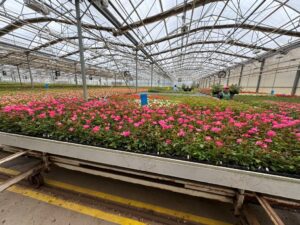
The Rose Project
By Kim Syrus
Many Australian growers have investigated alternative ways to produce field roses grown on their own roots. Unfortunately, the results of these ventures have, in the main, been less than successful. Aware that rose growers in both the United States and Europe have successfully transitioned portions of their crop to cutting-grown plants, I applied and was awarded a Hort Innovation Churchill Fellowship. The primary aim of my fellowship was to explore practical ways Australian in-ground rose growers, who currently bud their crop could transition all, or a portion of their crop, to own-root cuttings.
The production of in-ground roses remains essential for the Australian rose market. Producing 2-3 million bare-root roses each year, these plants form the backbone of rose sales: bagged and sold in garden centres, or bulk lots transported across the country (at a fraction of the freight cost of equivalent potted plants) to be potted and sold to local wholesalers, retailers, landscapers and home gardeners.
In recent years, the American rose industry has seen a significant transformation in the rise of own-root rose production. This shift is not only reshaping how roses are grown and sold but also presenting compelling benefits for both growers and garden enthusiasts alike.
While traditional budded roses have long dominated the USA market, own-root roses are making their mark with industry estimates showing own-root plants now represent around 70 per cent of all roses sold in the United States, a figure that has been steadily increasing over the past decade.

Central to the successful transition from budded to own-root plants in the United States has been Greenheart Farms, Arroyo Grande, California. Owner, Bill De Vor has trialled and refined growing systems so his skilled workforce can successfully make millions of small, rooted rose plugs. These plugs of assorted rose varieties are distributed and planted in fields across the country.
One of those growers is NeuHouse Farms in Wasco, California. This multi-generational business has revolutionised the way field-grown garden roses are produced. Purchased plugs are loaded and machine-assist planted in prepared ground. Hectares and hectares fill with precisely spaced plants and rows, culminating in an eye-watering eleven million roses grown per annum.
The move towards own-root roses across Europe is nowhere near as advanced as the USA due mainly to the presence of cheap Eastern European budded roses, plus, by Australian standards, northern Europe’s relatively short growing season. It was noted by some European growers that roses grown on their own roots are a ‘little weaker’ compared to budded plants. However, the additional 2-3 months of growing weather, as we have in southern Australia, would be of great benefit to own-root plant development and possibly curtail that issue.
Another aspect to transitioning away from heavy reliance on budders was identified on a visit to France Pilté in Quiers-sur-Bezonde, France, where owner Jean-Marc Pilté noted fewer people were taking up rose budding, and fewer children were progressing into their parent’s rose businesses. So, a move to own-root production, by simplifying the rose growing process, is critical to assist in encouraging the next generation into family businesses and help futureproof the in-ground rose growing industry.
Grading standards for bare-root plants in both the USA and Europe have reduced the number of varieties selected to be own-root grown. Many rose varieties, when grown on their own roots, do not develop the fibrous root system or basal branching needed to comply with the standards. While these discarded varieties still develop into well-balanced mature roses when planted, they are not offered for bare-root sale.
As Australia does not have a bare-root plant grading system for either budded or own-root roses, many varieties currently not grown on their own roots in the USA and Europe may be well-suited to growing on their own roots to produce a saleable plant for Australian consumers. This potentially offers Australian in-ground rose growers a much larger catalogue of own-root rose varieties to choose from.

The vast majority of USA and European in-ground rose growers favour planting plugs sourced from a propagator, or in a few cases, their own in-house plug production.
Growing roses from hardwood cuttings presents several challenges. One major issue is the variability in rooting success, from less than 10 per cent at one end of the spectrum to 90 per cent plus at the other. A variety that achieves a 70-75 per cent strike success rate is considered good. Given most Australian growers view hardwood cuttings as a potential entrée into own-root growing, there is much work to be done to ensure a successful transition to own-root production.
Testing and trialling a wide range of rose varieties on their own roots as both plugs and hardwood is essential, as is setting up testing plots amongst in-ground rose growers. Sharing of knowledge between in-ground rose growers on own-root growing successes and failures will greatly assist the process.
Who will Australia’s inground rose growers be in 10 years? Simplified growing techniques, such as own-root roses, may encourage a new generation to get some dirt under their fingernails and continue the Australian rose growing legacy.
It became increasingly clear during my fellowship that the path towards in-ground own-root growing in Australia will be complex but achievable, and simply requires time, commitment, and vision to fulfill those ambitions.
Post my journey, and an essential part of the fellowship, I published a report covering a range of topics pertinent to Australia’s in-ground rose growers to assist in developing strategies towards reducing reliance on budded plants by creating a new propagation model for own-root roses.
My Hort Innovation Churchill Fellowship report is available for download at:
Click Search / Type ‘Kim Syrus’ / Click on ‘Download Report’.
All images supplied by the author.
Kim Syrus
Managing Director
Corporate Roses Pty Ltd
M: 0417 814 232
E: admin@corporateroses.com.au
